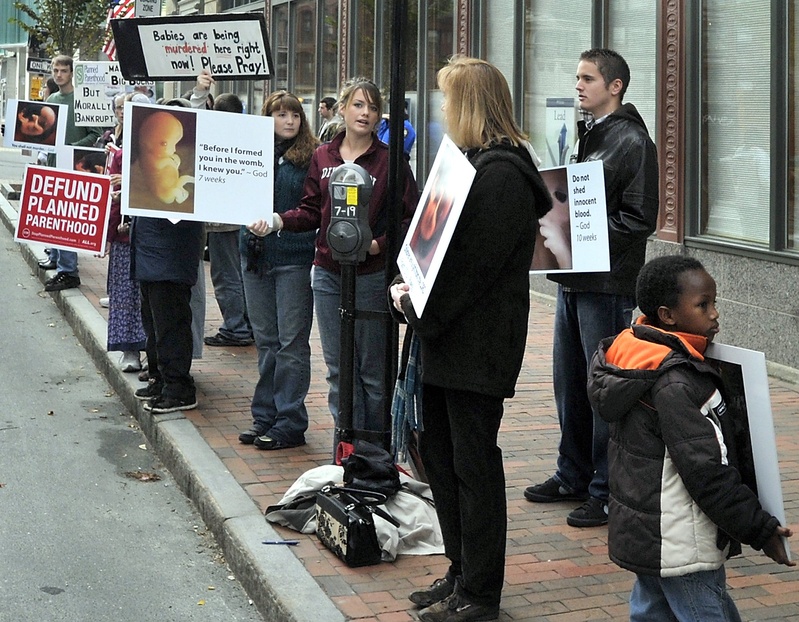WASHINGTON — The Supreme Court agreed Monday to hear a challenge to a Massachusetts law that restricts protests outside abortion clinics.
The state law creates a 35-foot “buffer zone” around reproductive health care facilities’ entrances, exits and driveways. Within the buffer zone, it is a crime for speakers to “enter or remain on a public sidewalk” during business hours. The law makes an exception for employees performing work duties, such as assisting and protecting patients.
Massachusetts created the law in response to reports of violence in front of the clinics. Anti-abortion advocates would physically block doorways and harass and intimidate patients seeking medical care.
Mark Rienzi, attorney for the law’s opponents, said the law violates the protesters’ freedom of speech.
“The state will let them walk silently past the abortion clinic to go elsewhere, but threatens prison if they so much as utter, ‘May I help you?’ while they walk,” Rienzi wrote in a brief.
Opponents of the law, including Eleanor McCullen, who, outside a clinic in Boston, tries to persuade women not to have abortions, argue that the exception for employees amounts to more protection for pro-abortion rights than anti-abortion advocates, violating the First Amendment’s free speech protections.
Gregory Smith, a demonstrator involved in the case, displays a crucifix as he loudly prays and sings hymns outside a clinic, intending for patients to hear. Sometimes he brings a loudspeaker to amplify group prayers. Other demonstrators have displayed baby caskets and dressed as the grim reaper.
“The law in this case discriminates about who can speak and what they can say on public sidewalks,” Rienzi said in an email Monday. “Massachusetts cannot threaten peaceful speakers with jail time for engaging in peaceful speech, with willing listeners, on a public sidewalk.”
Rienzi contends that employees use the exception to promote a pro-abortion rights standpoint, saying things to patients such as “abortion is legal,” “it’s important for women to have a choice,” and “don’t listen to her.”
An appellate court rejected challenges in 2009 and again in 2013, holding the law constitutional.
“The right of the state to take reasonable steps to ensure the safe passage of persons wishing to enter health care facilities cannot seriously be questioned,” the 1st U.S. Circuit Court of Appeals stated. “The Massachusetts statute at issue here is a content-neutral, narrowly tailored time-place-manner regulation that protects the rights of prospective patients and clinic employees without offending the First Amendment rights of others.”
Massachusetts, represented by Attorney General Martha Coakley, argues that the law only limits the time and place the speech can occur, so protesters can speak freely outside the zone.
“(They) remain free to engage in any type of speech and to offer any type of information they wish, so long as they do not do so within a clearly marked and posted buffer zone during clinic business hours,” Coakley wrote.
The Massachusetts Legislature enacted the original law in 2000 in the interest of protecting women who were seeking medical care at those facilities. There was a history of violence and intimidation against those women, so a floating buffer zone of 18 feet was established.
In 2007, the Legislature determined that the law still wasn’t doing enough to protect patients. It amended the law to make the zone fixed and to extend the radius of the buffer zone to 35 feet. A fixed buffer zone means no one can engage in speech within a static area around a clinic within the set time, while a floating buffer zone only applies within a certain distance of patients.
The case challenges precedent set in a 2000 case from Colorado, where a law established a floating buffer zone of 100 feet around a health care facility’s entrance for similar reasons. The court ruled that law was constitutional in a 6-3 decision.
The Supreme Court will hear oral arguments in the case next term, which begins in October.
Send questions/comments to the editors.



Success. Please wait for the page to reload. If the page does not reload within 5 seconds, please refresh the page.
Enter your email and password to access comments.
Hi, to comment on stories you must . This profile is in addition to your subscription and website login.
Already have a commenting profile? .
Invalid username/password.
Please check your email to confirm and complete your registration.
Only subscribers are eligible to post comments. Please subscribe or login first for digital access. Here’s why.
Use the form below to reset your password. When you've submitted your account email, we will send an email with a reset code.